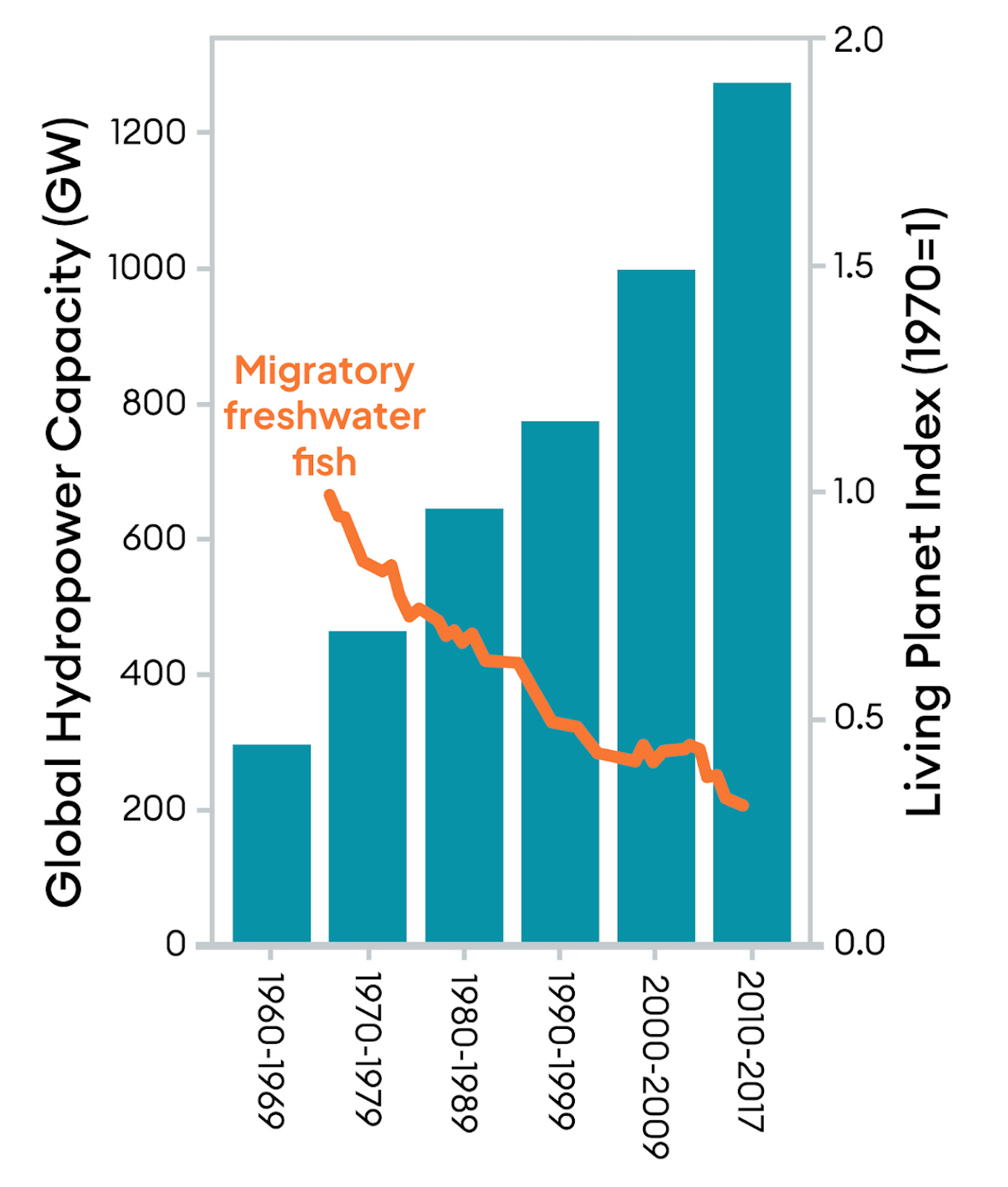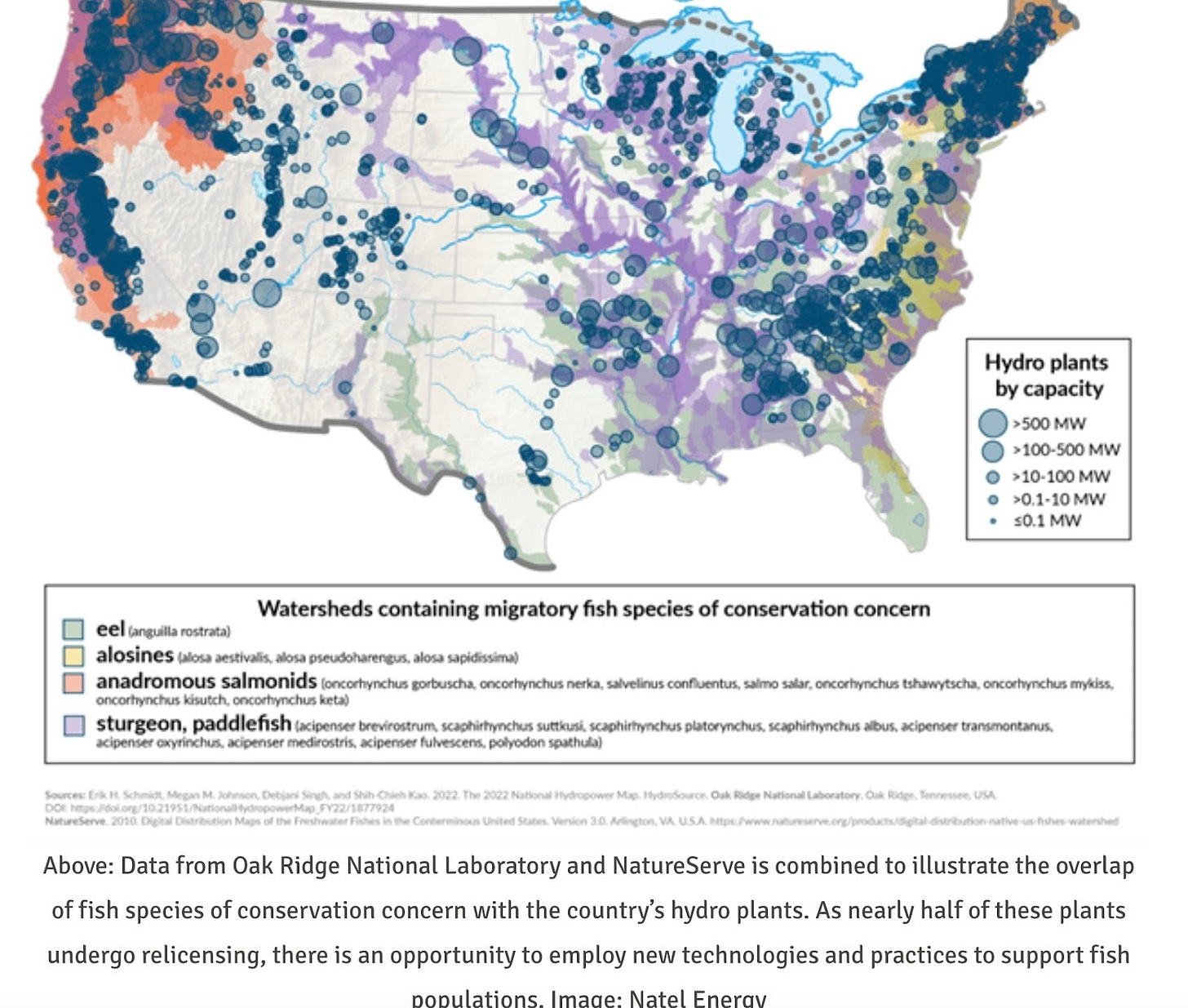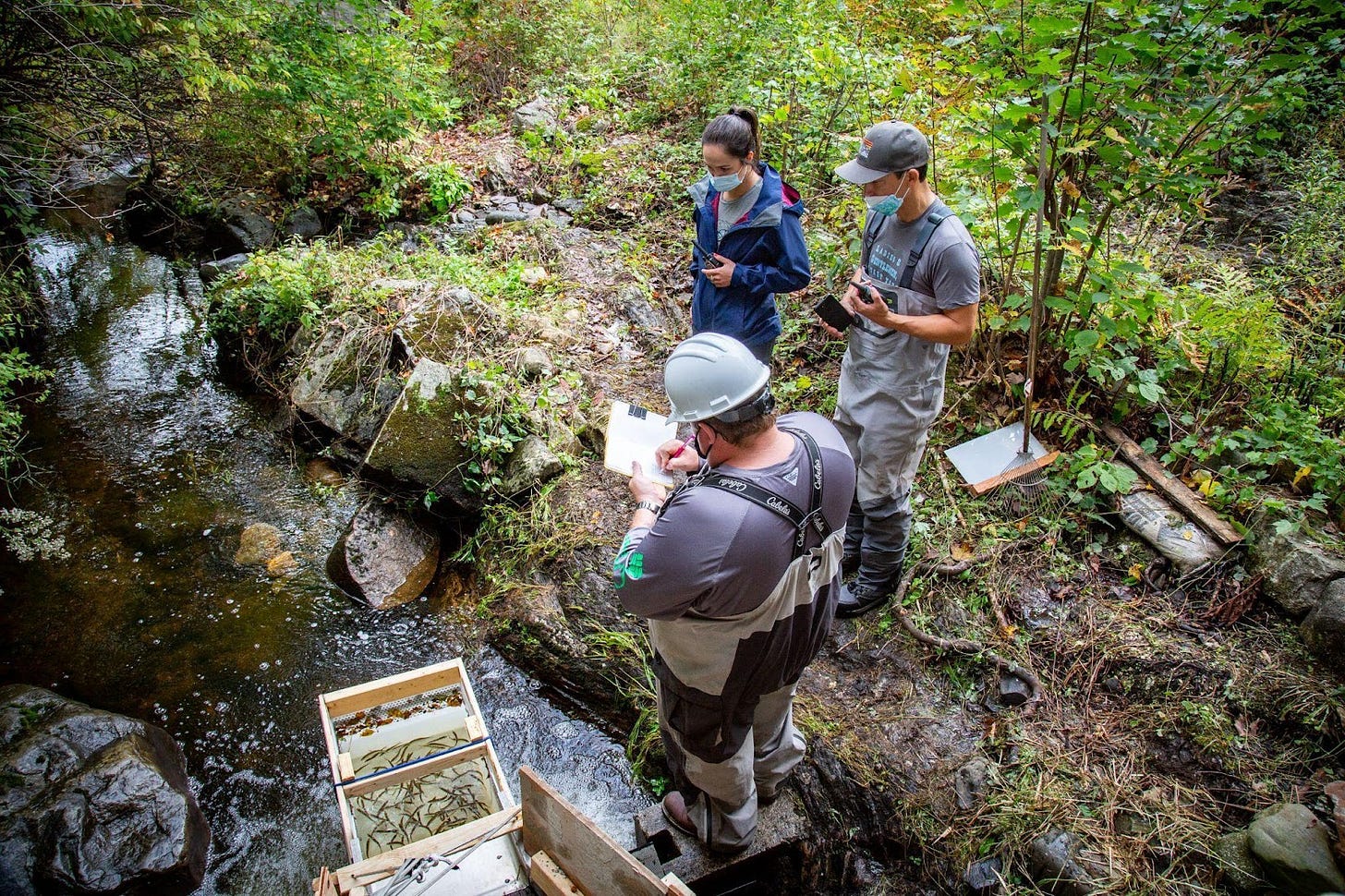A Once-in-a-Generation Opportunity to Modernize Hydropower and Protect the Fish in Our Waters
by Gia Schneider, Co-founder & Chief Commercial Officer of Natel Energy
The global transition to a zero-carbon grid is no longer just an aspiration—it’s an urgent necessity. As the third largest global electricity source, hydropower plays a critical role in stabilizing the grid alongside intermittent renewables like wind and solar. Its flexibility ensures reliable power generation, swiftly compensating for fluctuations caused by weather changes. Hydropower provides 40% of U.S. renewable electricity and delivers carbon-free power to over 30 million Americans. Globally, it remains the largest renewable energy source, with 1,300 gigawatts of installed capacity, a position expected to hold through at least 2028.
But for all its benefits, hydropower has a huge opportunity for improvement; that is in its relationship with fish. Unfortunately, roughly one in five fish passing through a conventional hydro turbine is killed. Thin, sharp blades spinning at very high speeds traditionally do not present an ideal outcome for the millions of fish that inhabit the waters where hydropower operates. Multiply this by the number of hydropower facilities a fish encounters when migrating downstream, and the cumulative impact on fish survival is staggering. The graphic below illustrates just how intertwined hydropower and migratory fish are and highlights how this overlap is especially fraught when it comes to fish species that warrant additional conservation efforts.
As the need for renewable energy sources continues to grow, hydropower will remain a critical backbone to the energy transition, but it has to modernize, to better accommodate the aquatic life beneath the surface. Right now, the inverse relationship between hydropower growth and migratory fish species decline is not sustainable.

But, the good news is that there are solutions to support the growing issue, albeit some more promising than others.
Understanding the Status Quo
Traditional options to improve fish protection at hydropower sites include fish screens and fish bypasses. These solutions aim to prevent fish from entering hydro turbines while enhancing their survival rates. However, both approaches are costly—requiring significant capital investment for installing screens or bypass systems, and ongoing expenses for maintenance, as fine screens often trap debris and need frequent cleaning. Additionally, these methods reduce power generation by diverting water away from the turbines, lowering overall plant efficiency. They do represent an improvement for fish but are not a viable solution for the broader hydropower industry, where many hydropower plants operate in environments where the large volumes of water passing through the plants make these fish protection measures challenging and expensive to install, operate, and maintain.
What’s Needed?
Solutions that support fish passage without compromising energy output efficiency or requiring significant CapEx or OpEx investments rely on designs that maintain both power performance and high fish passage survival rates. For successful downstream fish passage, options like Natel’s FishSafe turbine design use novel blade designs that are thick and slanted to create an airbag-like flow phenomenon that allows 98% of fish to safely pass through a hydro turbine, including even the most challenging-shaped fish (think eel).
For safe upstream passage, FishHeart’s floating hydraulic fishway supports fish safely while simultaneously helping hydropower plants use their water resources efficiently.
For both solutions, energy efficiency is not compromised. Turbine runners do not need to be slowed down to pass fish, water is not diverted, and hydro plant operations are not halted (with energy loss) to clean exclusion screens. In the case of downstream through-turbine passage design, sediment can pass freely through the turbine as well, maintaining a healthy river ecosystem and supporting the natural flow needed for a thriving, free-flowing river without damaging the turbine blades.
But, Why Now?
One of hydropower’s greatest challenges today is age. Over half of the existing hydropower fleet in North America and Europe is more than 50 years old. As these plants come up for relicensing, they will face new environmental requirements, particularly for fish passage. This represents both a challenge and an opportunity.
Globally, an estimated $127 billion will need to be spent on modernizing hydropower plants by 2030, with $14 billion a year allocated to new equipment and upgrades at existing plants. The question is: how do we make these necessary upgrades in a way that not only modernizes our energy infrastructure but also meets the pressing need to protect aquatic biodiversity?
By updating old infrastructure with turbines that are designed to be safe for fish, hydropower plant operators can meet relicensing requirements for fish passage without additional costly modifications. In many cases, upgrading turbines can result in increased energy production, making it a win-win for both the environment and the energy industry.
And with 16 GW of hydro licenses set to expire between 2020 and 2035, there is an urgent need to draw attention to newer hydropower innovations that can give owners and operators the modernizations they need to ensure renewable hydropower remains online.
A Once-in-a-Generation Opportunity
Hydropower plants have long lifespans, often operating for 50 to 100 years, with relicensing cycles occurring every 30 to 50 years. The modernization process now underway represents a once-in-a-generation opportunity to make lasting improvements—not only in terms of energy efficiency but also in environmental performance.
The path forward for hydropower must include both modernization and ecological stewardship. With the right investments and technologies, we can ensure that hydropower remains a vital part of the clean energy transition while also protecting the rivers and species that sustain us. Hydropower has the potential to help, rather than harm, the environment—and we’re committed to making that vision a reality.
The decisions we make today will either safeguard our rivers and ecosystems for generations or put them at further risk. We cannot afford to delay.
🍿 The Lean Back
Check out the new ‘Where the Internet Lives’ series from Google and Pique Action.
🎙️ MCJ Podcast
🏭 Erica Nemser, CEO at Ardent, discussed how her company’s technology stands out in the point source capture field, the industry's varied approaches to decarbonization, and how her leadership has guided the company's transformation. Listen to full episode here.
🏢 Molly Yang is the CEO and co-founder of Hgen, a company that develops clean hydrogen to decarbonize heavy industry. Molly and Cody talk all about Hgen's origin story, technology, and market. Listen to the episode here.
👩💻 Climate Jobs
For more open positions, check out the Job Openings space in the MCJ Collective member hub or the MCJ Job Board.
Production Manager and Sr Mechanical Engineer at Clean Crop (Holyoke, MA)
Sr Electrical Engineer at Crusoe (Tulsa, OK)
Head of People at Heirloom (Brisbane, CA)
Sr Process Engineer at Mantel (Cambridge, MA)
Marketing Specialist at Opna (London, UK)
Head of Communications at Quilt (SF Bay Area)
Strategic Finance Manager at Runwise (New York, NY)
Product Engineer at Windfall Bio (Sam Mateo, CA)
VP of Finance at Zeno (Remote)
👩💻 Events
🗳️ Hour of Action with Adam Met of AJR: TODAY! Join this special Hour of Action with Adam Met of multi-platinum pop band AJR and the nonprofit Planet Reimagined! In 60 minutes, we'll hear from Adam and then take meaningful action to Get Out The Vote (GOTV) for the 2024 Election. This Hour of Action, we are diving into phone banking – making calls to boost voter turnout. You don’t need to be an expert —the script and event host will provide you with all the info you need! Not into phone banking? That’s OK! We have plenty of equally productive and impactful alternatives you can do during our time together.
🌍 Europe Climate Week 2024: 5 days of free virtual events featuring leading climate experts and organizations, plus local community meetups across Europe for professionals exploring climate career opportunities. See the whole schedule from November 4-8 at EuropeClimateWeek.org
The MCJ Collective Newsletter is a free weekly email curating news, jobs, My Climate Journey podcast episodes, and other noteworthy happenings in the MCJ member community.
💭 If you have feedback or items you’d like to include, feel free to reach out.
🤝 If you’d like to join the MCJ Collective, apply today.
💡 Have a climate-related event or content topic that you'd like to see in the MCJ newsletter? Email us at content@mcj.vc





One of the coolest postings on the MCJ newsletter that I've seen. What an inspiring technology from Natal. Best of luck!